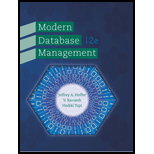
(a)
Definition of File organization.
Explanation of Solution
A file organization is a process of arranging files on the secondary storage devices. It is a technique for arranging the records of a file physically on secondary storage devices.
Objectives of file organization:
- It helps in doing fast Data retrieval.
- It helps in using the disk space properly and effectively.
- It provides data protection.
- Minimizes the need for re-organization of data and files.
- Security from unauthorized access.
For a table or physical file, while choosing a file organization for a
- every file organization must provide Fast data retrieval
- High speed processing of input data and maintenance of transactions.
- Storage space must be use efficiently
- Protection from data redundancy
- Protection from data loss or failure
- It must provide security to data from unauthorized user
(b)
Definition of Heap file organization.
Explanation of Solution
In Heap file organization the data is not stored in any series or sequence. It is an inefficient file organization method for complex database system. It does not provide efficient searching and sorting operations. It is useful only for small file structures. deletions and modification of data is also a major complex task in this file organization as the data is stored without any proper sequencing. Memory requirement for the data is more and this file organization does not provide any memory management technique for memory. Using this file organization is time consuming.
(c)
Definition of Sequential file organization.
Explanation of Solution
Sequential file organization is simple, fast and efficient. In this file organization records are stored in a sequential manner according to the primary key value. Searching a record in this file organization is a time-consuming process. Whole file needs to be scan, in order to find a record. While adding or Updating a record, it requires rewriting of file. During the deletion of record, it creates wasted space or require reorganizing.
(d)
Definition of Indexed file organization
Explanation of Solution
Index file organization is used to store the records in the memory with the index values. Indexed file organization provides fast access to records. It does not waste any memory space but requires extra memory to create an index. Adding and updating the records requires the dynamic allocation of data, and it also requires the maintenance of indexes. Searching and deletion operations are faster. Records can be stored either sequentially or non-sequentially.
(e)
Definition of Hashed file organization.
Explanation of Solution
It is a storage system in which the hashing
(f)
Definition of Denormalization.
Explanation of Solution
Denormalization: A process of Denormalization transforms normalized relations into non-normalized implementation specifications. Denormalization is done to improve the efficiency of input-output operations by specifying the database implementation structure so that data elements that are required together are also accessed together on the physical medium. Partitioning is also considered a form of Denormalization. Horizontal partitioning divides a relation into two or more record by placing different rows into different tables, based on common column values. Vertical partitioning distributes the columns of a relation into separate files, repeating the primary key in each of the files.
(g)
Definition of Composite key.
Explanation of Solution
Composite key: it is an attribute or a combination of attributes that identifies a row in a relation uniquely.
(h)
Definition of Secondary key.
Explanation of Solution
Among those candidate keys which are not opted for as primary key are knows as secondary key.
(h)
Definition of Data type
Explanation of Solution
Data type: DBMS has a defined list of data types. It contains numeric, string, and date/time-type variables etc.Selection of a data type is done based on data values that need to be stored in it. Some examples of the data types are: String, Number, Temporal, Boolean,etc.
(i)
Definition of Join index.
Explanation of Solution
Join index: it is an index of columns from two or more tables that come from the same domain of values.
Want to see more full solutions like this?
Chapter 5 Solutions
Modern Database Management (12th Edition)
 Database System ConceptsComputer ScienceISBN:9780078022159Author:Abraham Silberschatz Professor, Henry F. Korth, S. SudarshanPublisher:McGraw-Hill Education
Database System ConceptsComputer ScienceISBN:9780078022159Author:Abraham Silberschatz Professor, Henry F. Korth, S. SudarshanPublisher:McGraw-Hill Education Starting Out with Python (4th Edition)Computer ScienceISBN:9780134444321Author:Tony GaddisPublisher:PEARSON
Starting Out with Python (4th Edition)Computer ScienceISBN:9780134444321Author:Tony GaddisPublisher:PEARSON Digital Fundamentals (11th Edition)Computer ScienceISBN:9780132737968Author:Thomas L. FloydPublisher:PEARSON
Digital Fundamentals (11th Edition)Computer ScienceISBN:9780132737968Author:Thomas L. FloydPublisher:PEARSON C How to Program (8th Edition)Computer ScienceISBN:9780133976892Author:Paul J. Deitel, Harvey DeitelPublisher:PEARSON
C How to Program (8th Edition)Computer ScienceISBN:9780133976892Author:Paul J. Deitel, Harvey DeitelPublisher:PEARSON Database Systems: Design, Implementation, & Manag...Computer ScienceISBN:9781337627900Author:Carlos Coronel, Steven MorrisPublisher:Cengage Learning
Database Systems: Design, Implementation, & Manag...Computer ScienceISBN:9781337627900Author:Carlos Coronel, Steven MorrisPublisher:Cengage Learning Programmable Logic ControllersComputer ScienceISBN:9780073373843Author:Frank D. PetruzellaPublisher:McGraw-Hill Education
Programmable Logic ControllersComputer ScienceISBN:9780073373843Author:Frank D. PetruzellaPublisher:McGraw-Hill Education





